|

Alexander's Light Show
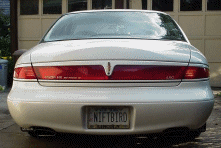
I have a '59 Thunderbird in
which I have installed blue dots. Blue dots are blue
pieces of glass a half inch in diameter in the shape of
a diamond with the tip cut off surrounded by a metal
ring that can be mounted in the red part of the
taillight. They were initially promoted as a safety
device in the 1920's. For the same intensity of light
blue can be seen farther than red, because our eyes are
more sensitive to blue. They were subsequently made
illegal, when states decided blue light should only be
used on emergency vehicles. Customizers continued to use
these until the 1960's on their cars, because blue dots
produce purple glow and streaks of blue light at night
that looks so cool .
Now people put all kinds of
colored bulbs in their signal and taillight assemblies.
I wanted to customize my new Mark VIII in this fashion,
but do it in more high tech approach. The way I have the
car setup, I can turn on strobe lights in my grill and
rear turn signals at flick of a dash switch.
Additionally I can change the color of the back up light
by the switches I have installed on the dash, because
there are now two additional bulb assemblies in the back
up light assembly. I can have the taillights
continuously red all across at night, or I can have a
blue dot type of effect using the blue bulb.
This is the switch panel that
I have located on the dash beside the rear defroster
switch:
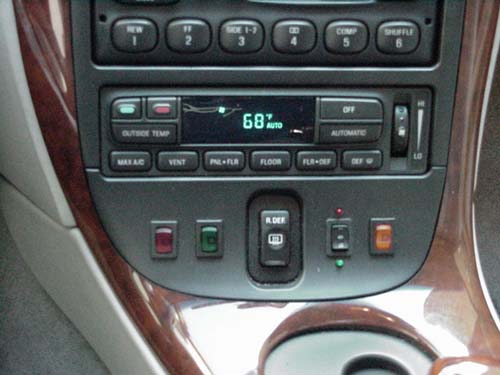
If you have the optional heated seats, the controls are
here where I put the switches, so you need to find an
alternate place to put the switches. I used mini rocker
switches available from NAPA auto stores. The LED's are
12 volt LED's that I picked up at a car show. These
rocker switches were difficult to mount neatly and
aesthetically, because the panel is asymmetrical and
curved. I needed to cut through the panel to mount the
switches. To do this right the first time, I cut out
silhouettes using Post-it note paper in the shape of the
rectangular holes I needed to drill out. I arranged
these on the back of the panel, carefully measuring the
spacing with a ruler, until I thought they looked right.
Next, I lightly sprayed the back with white paint. I
removed the Post-it notes. What I had left was an exact
template of where the holes needed to be drilled. I used
an ordinary drill to make the initial holes, then
finished making the contours of the rectangular holes
using jeweler's files.
This is a picture of the rear
of a modified left taillight assembly:
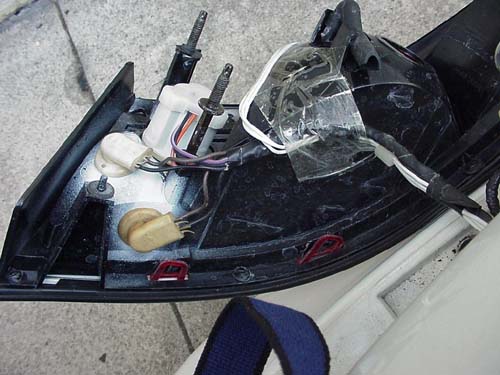
As you can see, there are two
additional marker light sockets in the back up light
assembly. One was used for a blue colored marker bulb,
the other for a red colored marker bulb. Additionally,
the single filament back up light socket has been
replaced by a dual filament turn signal type socket.
This gave me an extra filament that can be dash
controlled for a white light, while leaving the back up
light function unaffected. I use the additional white
light as a warning when idiots tailgate me.
These are ordinary marker
light sockets that can be found in most late model Ford
cars going back to the eighties. You can get them
cheaply in auto salvage yards. To mount these you will
need to cut out asymmetrical cross-like holes in the
taillight assembly. Trace out the contour of the cut out
using the the hole found on the marker light of your
stock Mark VII assembly shown here:
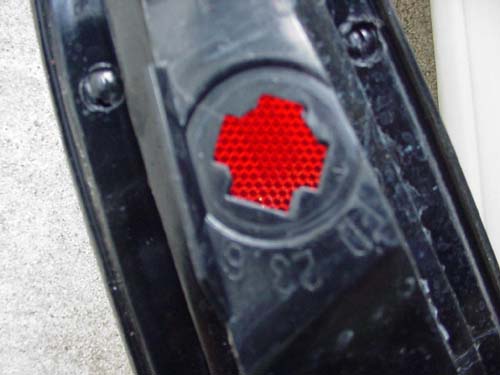
I cut these silhouettes out of
Post-it note paper, so I could again precisely determine
where to make the holes, before doing any drilling. I
used the same white paint method that I previously
described. I wanted to get this right the first time,
because these taillight cost $150 a piece from the
dealer in 1998. Remember when placing these holes, that
the socket rotates 45 degrees clockwise after insertion
in the hole before locking in. The left and right
taillight assemblies will be mirror images of where the
holes are placed, but not how they are oriented
rotationally. Hold the socket on the taillight in the
orientation that you want it to be mounted, then rotate
it counterclockwise 45 degrees. This is the orientation
of the hole that you want to cut out.
This is a picture of the left
taillight with the holes cut out:
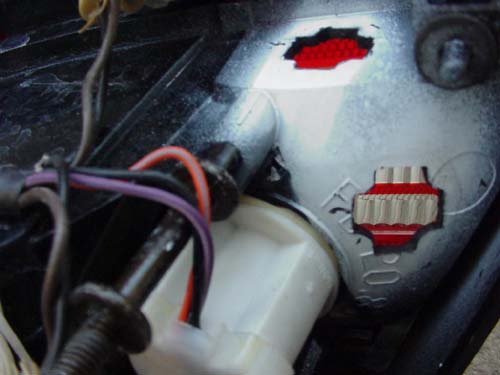
Another view of the left
taillight assembly:
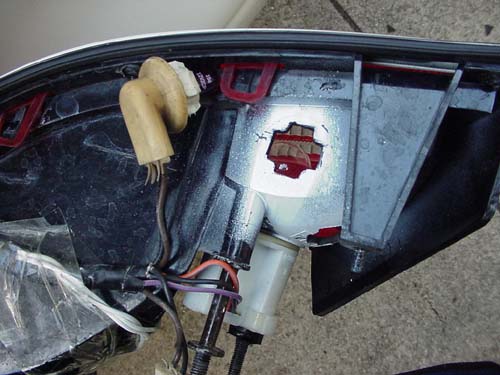
You can see the residual of the white paint I used to
make the outline of the holes using my Post-it note
system. Mounting the sockets in these positions will
give you no interference problems; the bulbs do not
touch, and the sockets clear the the opening for the
taillight assembly. Make sure the holes you make are
precise, so will have a waterproof seal. You don't want
water in your expensive taillights. Make sure you get
the flat type 90 degree type of marker socket pictured
here. The straight type of socket will give you
interference problems when reinstalling the taillight
assembly.
This is a view of the signal light part of the taillight
assembly where I drilled a hole for the low power strobe
light:
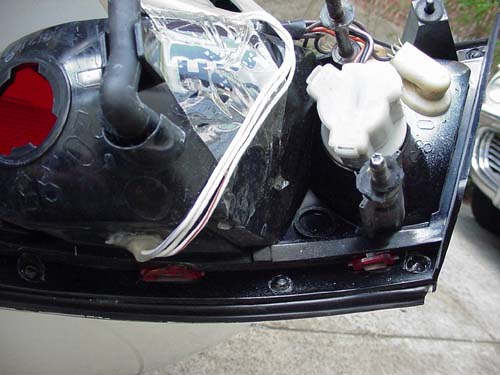
I used a generous amount of silicone glue to make the
assembly waterproof after putting in the strobe light.
Running the wires for this type of setup is
straightforward. I used the cigarette lighter positive
as my positive lead for all the lights, since it is
conveniently located in the console. I routed a 10
Ampere fuse in line with the lights to protect the
circuit. I used 14 and 16 gauge wire to the taillight
and switches. You will need to remove the back seat and
the console to route the wires.
This lightshow setup is lots of fun, but remember blue
lights and strobe lights are for off road use only. You
can be sited for these by the police if you use them on
the street. I, the club, and this site take no
responsibility in how you use these lights or any
damages that may result in their use or installation.
Good luck.
Alexander
President
Lincolns of Distinction

|

![]()
















